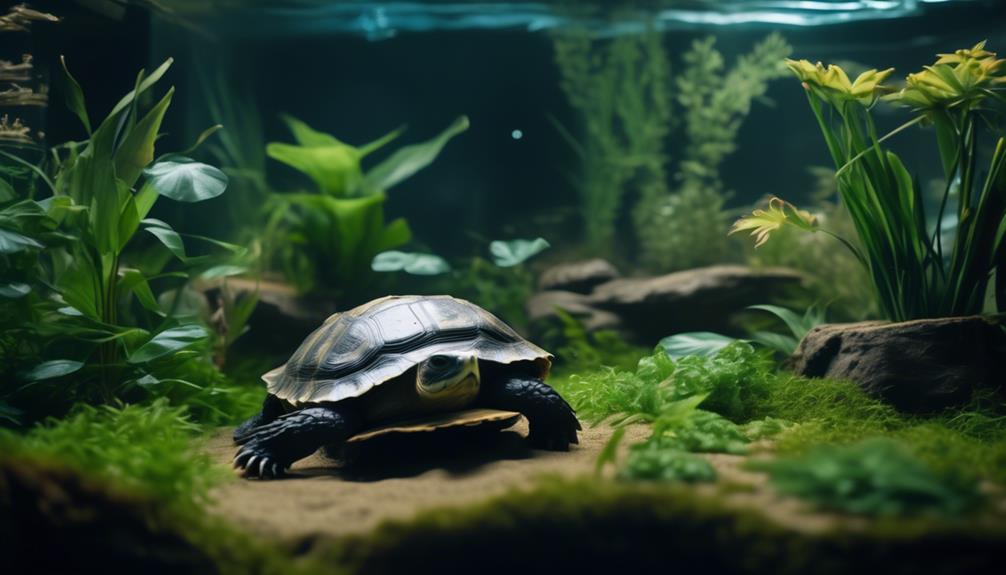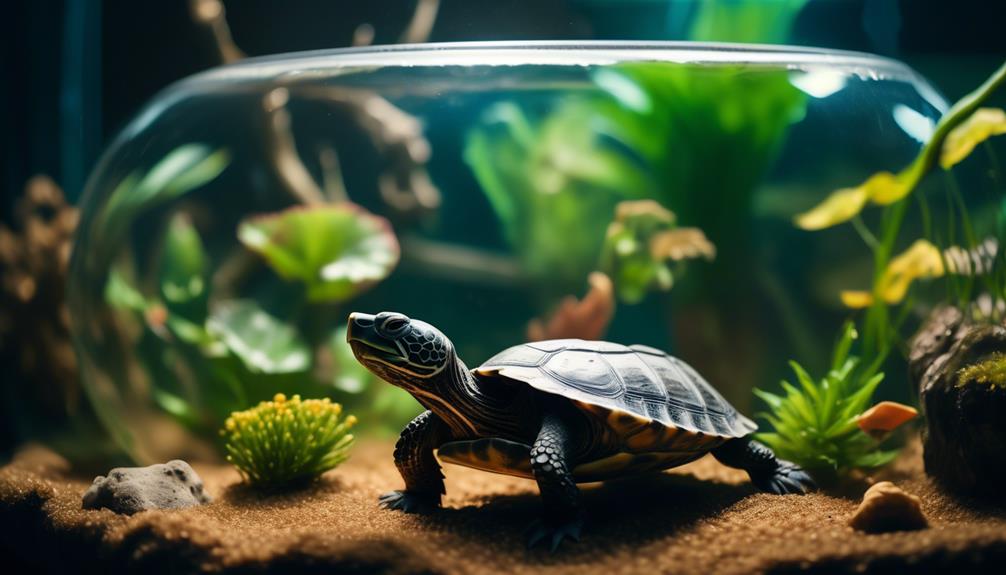Are you ready to embark on a journey of discovery and uncover the key to providing impeccable care for African Sideneck Turtles? Look no further as we guide you through the secrets of perfect turtle care.
With a focus on practical advice and expert tips, we will explore all aspects of these captivating creatures' well-being. From creating an ideal enclosure to ensuring the right lighting and temperature, we'll cover it all.
But that's not all, we'll also dive into the realm of water maintenance, decorative options, and the perfect balance of nutrition.
So, are you ready to unlock the secrets and take your turtle care to the next level? Let's dive in together and unravel the mysteries that await!
Key Takeaways
- African Sideneck Turtles require a minimum enclosure size of 90-110 gallons of water, with a retaining wall to prevent escape.
- Regular exposure to high-quality UVB lighting is necessary for their health, with recommended UVB bulbs and basking temperatures of around 95°F.
- Water maintenance is important, with the use of a canister-style filter and regular water changes.
- The enclosure should be decorated with a basking platform, plants, hiding spots, and other decor options to enhance functionality and attractiveness.
Enclosure Requirements for African Sideneck Turtles

To provide optimal living conditions for African Sideneck Turtles, it's important to adhere to specific enclosure requirements. These turtles require a minimum enclosure size of 90-110 gallons of water, not deeper than 1.5 times their length. Outdoor housing with a generously-sized pond and free heating and lighting is beneficial. It's recommended to have a retaining wall at least 18 inches tall and buried 6 inches into the ground to prevent escape.
Housing multiple turtles together should be avoided, except in large ponds. Larger enclosures are appreciated by the turtles.
When it comes to breeding habits, African Sideneck Turtles lay eggs and don't give live birth.
Common health issues in these turtles include respiratory infections, shell rot, and eye problems. It's crucial to maintain proper water quality and provide a suitable diet to keep them healthy.
UVB Lighting and Basking Temperatures
Regular exposure to high-quality UVB lighting is essential for the optimal health of African Sideneck Turtles. UVB lighting is crucial for reptiles as it enables them to synthesize vitamin D3, which is necessary for calcium metabolism and the prevention of metabolic bone disease.
To provide the proper UVB lighting, it's recommended to use bulbs such as the Zoo Med Reptisun T5 HO 5.0 or Arcadia Forest 6%. These bulbs should cover half the length of the enclosure and be placed close to the heat lamps.
Additionally, maintaining the ideal basking temperature is crucial for turtles' well-being. The basking platform should offer high temperatures of around 95°F, while the water temperature should be under 85°F. It's important to use halogen flood heat lamps for warming the basking area and a high-quality aquarium heater if necessary to maintain the appropriate temperatures for the turtles' health.
Water Maintenance for Turtle Enclosures

Maintaining clean and healthy water is crucial for the overall well-being of African Sideneck Turtles. Following the importance of UVB lighting and basking temperatures, water quality plays a significant role in the health of these turtles. It's essential to choose the right filtration system to ensure optimal conditions.
A canister-style filter that's rated for 2-3 times the volume of the enclosure is recommended to keep the water clean. Regularly replacing 30% of the water volume every 1-2 weeks is also necessary to maintain water quality.
It's important not to settle for cheap filters, as they may not effectively remove waste and contaminants. By prioritizing water maintenance and choosing the right filtration system, turtle enthusiasts can provide a healthy and thriving environment for African Sideneck Turtles.
Decor Ideas for Sideneck Turtle Enclosures
When creating a suitable enclosure for African Sideneck Turtles, it's important to consider various decor options to enhance both the functionality and attractiveness of the habitat. Here are some decor ideas that can provide a sense of security and natural beauty to the enclosure:
- Hiding spots: Providing hiding spots such as hollow logs or caves allows the turtles to retreat and feel secure. This helps reduce stress and promotes natural behaviors.
- Live plants: Incorporating live plants not only adds aesthetic value to the enclosure, but also provides additional hiding spots and a source of enrichment for the turtles. Plants like Anubias, Java Fern, and Water Hyacinth are suitable options.
- Driftwood: Adding driftwood can create a more natural and visually appealing environment for the turtles. It also serves as a basking area and provides opportunities for climbing and exploration.
Feeding Guidelines for African Sideneck Turtles

To ensure the optimal health and well-being of African Sideneck Turtles, it's important to follow specific feeding guidelines that provide a balanced diet for these omnivorous reptiles. Proper nutrition for Sideneck Turtles involves understanding their dietary requirements at different stages of life.
Younger turtles, under one year, should be fed a diet consisting of 50% protein and 50% vegetables. Animal-based foods such as crickets, earthworms, and freeze-dried shrimp should be offered to provide the necessary protein. Vegetable-based foods like collard greens, dandelion greens, and raw grated squash should also be included in their diet.
As they grow older, turtles over one year require a diet with 25% protein and 75% vegetables. This shift in percentages reflects the changing nutritional needs of the turtles as they mature.
Additionally, offering turtle pellets as a supplement ensures a well-rounded diet for these fascinating creatures. Turtle pellets are specially formulated to provide the necessary vitamins and minerals that may be lacking in a natural diet.
Following these feeding guidelines will help maintain the proper nutrition for African Sideneck Turtles. By providing a balanced diet that meets their specific nutritional needs, you can help ensure the long-term health and well-being of these amazing reptiles.
Frequently Asked Questions
Can African Sideneck Turtles Be Kept in Groups or Should They Be Housed Alone?
African sideneck turtles can be housed together in large ponds, but not in smaller enclosures. Keeping them in groups has pros and cons, including social interaction but also potential territorial disputes. They generally cannot coexist with other turtle species.
What Are the Potential Risks of Not Providing UVB Lighting for African Sideneck Turtles?
Not providing UVB lighting for African Sideneck Turtles can pose potential health risks. UVB lighting is crucial for their optimal health as it aids in calcium absorption, prevents shell deformities, and promotes overall well-being.
How Often Should the Water in the Turtle Enclosure Be Tested for Water Quality?
We need to regularly test the water in our turtle enclosure to ensure its quality. Water quality is crucial for the health and well-being of our African Sideneck Turtles, so testing frequency is of utmost importance.
Are There Any Specific Types of Plants or Substrate to Avoid Using in the Turtle Enclosure?
Plants to avoid in African Sideneck Turtle enclosures include toxic varieties like ivy, daffodils, and lilies. Opt for safe options like water lettuce, duckweed, and anubias. Substrate options should be fine-particle, non-toxic, and easy to clean.
Can African Sideneck Turtles Eat Fruits as Part of Their Diet?
Yes, African Sideneck Turtles can eat fruits as part of their diet. However, it should be offered in moderation, as a supplement to their balanced omnivorous diet. Providing a variety of housing options is essential for their well-being.
Conclusion
In conclusion, providing the perfect care for African Sideneck Turtles is a rewarding and fulfilling responsibility. By following the essential guidelines outlined in this article, you can create a suitable habitat, maintain optimal lighting and temperatures, and ensure clean and healthy water for your turtle.
Remember, 'A happy turtle is a healthy turtle.' So, embrace your role as a turtle care expert and unlock the secrets to providing the best care possible for your African Sideneck Turtle.



